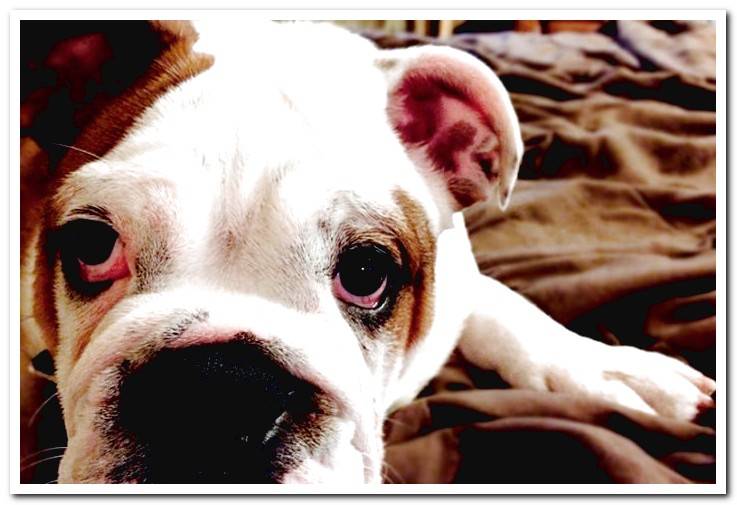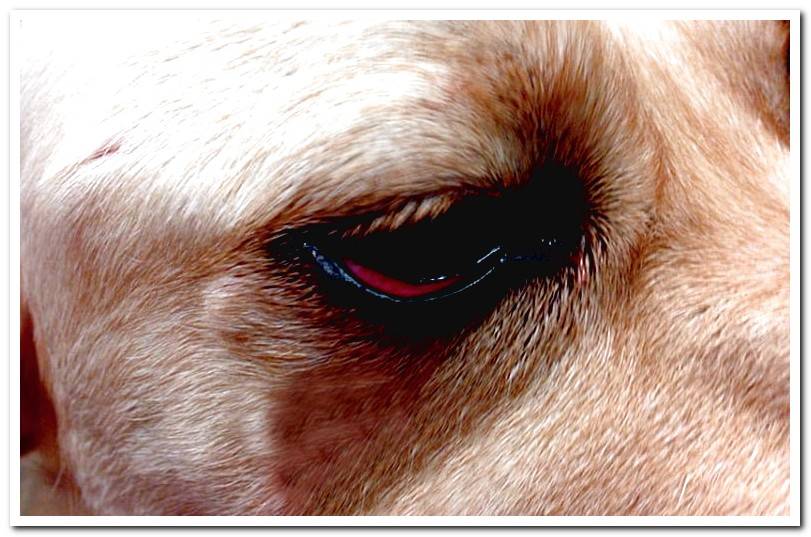
There are different circumstances in which we can see the eyes of our dog red and several are the causes that can explain the redness. Some have no clinical relevance, while others are serious conditions that can lead to blindness.
Discarding the first, any questions about the eye health of our dog should be resolved by the vet. In eye pathologies, starting treatment early is very important in avoiding complications. Let’s see what are the most common causes.
Index of contents
- 1 Conjunctivitis, one of the main causes
- 2 Uveitis also reddens the eyes
- 3 Alterations of the third eyelid or nictitating membrane
- 4 Ocular ectropion
- 5 What is the cherry eye of dogs?
- 6 Care for red eyes in dogs
Conjunctivitis, one of the main causes
Conjunctivitis, also known as red eye, is the first cause that comes to mind when explaining red eyes in a dog. It consists of inflammation of the ocular conjunctiva and is a very common disorder.
There are some causes of conjunctivitis, such as allergies, contact with irritating substances, some systemic diseases such as distemper or, if it affects only one eye, foreign bodies or some hair that grows brushing the eye. It should be known that different types of conjunctivitis are distinguished depending on the clinical picture that is presented.
They are serous conjunctivitis, follicular or mucoid and purulent. Treatment should be prescribed by the veterinaryn after diagnosis. The symptoms that characterize conjunctivitis in general are the following:
- Redness of one or both eyes, since conjunctivitis can be uni or bilateral.
- Serous, mucoid, or purulent discharge. Thick secretions crust over the eyelids.
- Absence of pain, which is a very important fact when it comes to differentiating conjunctivitis from other ocular pathologies.
- In allergic conjunctivitis there is itching and the dog will rub his eyes and face.
Uveitis also reddens the eyes
This condition is also known as a soft eye. It is due to inflammation of certain eye structures, such as the iris, which controls the size of the pupil, and the ciliary body, which produces aqueous humor and controls the pressure inside the eye.
There are several causes of uveitis, such as bacterial infections, systemic diseases, ulcers on the cornea, etc. It is essential to go to the vet. It is a serious condition and a delay in treatment could lead to blindness or other serious complications. Its symptoms are the following:
- Pain.
- Red eye.
- Tearing.
- Squint.
- Photophobia, that is, intolerance to light.
- Protrusion of the third eyelid.
- Haze in the eye.
- Eye soft to the touch, sometimes.

Alterations of the third eyelid or nictitating membrane
Also known by the name of nictitating membrane, fulfills important functions in dogs. It is located in the inner corner of the eye. It is not normally visible, but on certain occasions it extends and partially or completely covers the ocular surface.
When prolapsed it gives the sensation that the eyeball has turned inside its orbit. Sometimes if the dog is sleeping this effect also occurs, looking like the eyes are blank. We have an example of how this membrane works when a foreign body enters the eye.
In these cases the third eyelid may unfold or bulge in an attempt to protect the eye. In addition to the protrusion of the membrane, other symptoms such as tearing, blinking, strabismus or itching can be seen. Protrusion of the nictitating membrane is reason for veterinary consultation.
Ocular ectropion
This condition involves eversion of the lower eyelid, causing it to separate from the surface of the eye. In consecuense, there is an area between both parts that we will see in red.
The eversion of this eyelid implies a lack of protection for the eye, which is exposed to any irritating agent. In the long run, specimens with ectropion can develop chronic conjunctivitis or damage to the cornea. It is a more frequent problem in dogs with sagging face skin, such as spaniel or hound types.
It is also more common in older specimens that have lost tone in this facial skin. Unless it does not cause any associated conditions, the vet should proceed with its surgical repair.
What is the cherry eye of dogs?
It is the prolapse of the lacrimal gland of the third eyelid. It appears when the holdings inside the third eyelid are weak, so that the lacrimal gland is exposed. At first glance we will appreciate a reddish cherry-like lump, hence its name. It is also known by the name of encantis.
The problem is that it ends up rubbing on the ocular surface, which can be a cause of conjunctivitis. The most common treatment at present consists of repositioning both the gland and the eyelid, resorting to surgical intervention.
Care for red eyes in dogs
The mildest cases of red eyes in dogs, such as some conjunctivitis, can be solved at home by keeping the eye clean, washing it with a gauze soaked in saline solution. We can repeat the application several times a day.
But, if the table does not subside in a day or two and the secretion and discomfort increase, you should go to the vet. In no case should we apply drugs to the eye on our own, not even an eye drop or an ophthalmic cream that we have previously used.
Identifying a foreign body in the eye, that it does not open normally, prolapse or, on the contrary, seems smaller, there is blood, changes in coloration, inflammation or any systemic symptoms is an emergency that should receive prompt veterinary assistance. .
